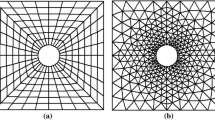Abstract
The problem of particulate flows at moderate to high concentration and finite Reynolds number is addressed by parallel direct numerical simulation. The present contribution is an extension of the work published in Computers & Fluids 38:1608 (2009), where systems of moderate size in a 2D geometry were examined. At the numerical level, the suggested method is inspired by the framework established by Glowinski et al. (Int J Multiph Flow 25:755, 1999) in the sense that their Distributed Lagrange Multiplier/Fictitious Domain (DLM/FD) formulation and their operator-splitting idea are employed. In contrast, particle collisions are handled by an efficient Discrete Element Method (DEM) granular solver, which allows one to consider both smoothly (sphere) and non-smoothly (angular polyhedron) shaped particles. From a computational viewpoint, a basic though efficient strategy has been developed to implement the DLM/FD method in a domain decomposition/distributed fashion. To achieve this goal, the serial code, GRIFF (GRains In Fluid Flow; see Comput Fluids 38:1608–1628, 2009) is upgraded to fully MPI capabilities. The new code, PeliGRIFF (Parallel Efficient Library for GRains in Fluid Flow) is developed under the framework of the fully MPI open-source platform PELICANS. The parallel computing capabilities of PeliGRIFF offer new perspectives in the study of particulate flows and indeed increase the number of particles usually simulated in the literature. Solutions to address new issues raised by the parallelization of the DLM/FD method and assess the scalable properties of the code are proposed. Results on the 2D/3D sedimentation of a significant collection of isometric polygonal/polyhedral particles in a Newtonian fluid with collisions are presented as a validation test and an illustration of the class of particulate flows PeliGRIFF is able to investigate.
Similar content being viewed by others
References
Glowinski R, Pan TW, Hesla TI, Joseph DD (1999) A distributed Lagrange multiplier/fictitious domain method for particulate flow. Int J Multiph Flow 25: 755–794
Glowinski R (2003) Finite element methods for incompressible viscous flow. In: Ciarlet PG, Lions JL (eds) Handbook of numerical analysis, vol IX. North-Holland, Amsterdam, pp 3–1176
Wachs A (2009) A DEM-DLM/FD method for direct numerical simulation of particulate flows: sedimentation of polygonal isometric particles in a Newtonian fluid with collisions. Comput Fluids 38(8): 1608–1628
Singh P, Hesla TI, Joseph DD (2003) Distributed Lagrange multiplier method for particulate flows with collisions. Int J Multiph Flow 29: 495–509
Glowinski R, Pan TW, Hesla TI, Joseph DD, Periaux J (2001) A fictitious domain approach to the direct numerical simulation of incompressible viscous flow past moving rigid bodies: application to particulate flow. J Comput Phys 169: 363–426
Pan TW, Joseph DD, Glowinski R (2001) Modelling Rayleigh–Taylor instability of a sedimenting suspension of several thousand circular particles in a direct numerical simulation. J Fluid Mech 434: 23–37
Feng ZG, Michaelides EE (2005) Proteus: a direct forcing method in the simulations of particulate flows. J Comput Phys 202: 20–51
Uhlmann M (2005) An immersed boundary method with direct forcing for the simulation of particulate flows. J Comput Phys 209: 448–476
Tsuji T, Yabumoto K, Tanaka T (2008) Spontaneous structures in three-dimensional bubbling gas-fluidized bed by parallel DEM–CFD coupling simulation. Powder Technol 184(2): 132–140
Tsuji T, Ito A, Tanaka T (2008) Multi-scale structure of clustering particles. Powder Technol 179(3): 115–125
Jin S, Minev PD, Nandakumar K (2009) A scalable parallel algorithm for the direct numerical simulation of three-dimensional incompressible particulate flow. Int J Comput Fluid Dyn 23(5): 427–437
Veeramani C, Minev PD, Nandakumar K (2007) A fictitious domain formulation for flows with rigid particles: a non-Lagrange multiplier version. J Comput Phys 224: 867–879
Yu Z, Shao X, Wachs A (2006) A fictitious domain method for particulate flows with heat transfer. J Comput Phys 217(2): 424–452
Yu Z, Wachs A (2007) A fictitious domain method for dynamic simulation of particle sedimentation in Bingham fluids. J Non-Newton Fluid Mech 145(2–3): 78–91
Crowe C, Sommerfeld M, Tsuji Y (1998) Multiphase flows with droplets and particles. CRC Press, New York
Cundall PA, Strack ODL (1979) A discrete numerical model for granular assemblies. Geotechnique 29: 47–65
Wu CY, Cocks ACF (2006) Numerical and experimental investigations of the flow of powder into a confined space. Mech Mater 38: 304–324
Komiwes V, Mege P, Meimon Y, Herrmann H (2006) Simulation of granular flow in a fluid applied to sedimentation. Granul Matter 8: 41–54
Yu Z, Wachs A, Peysson Y (2006) Numerical simulation of particle sedimentation in shear-thinning fluids with a fictitious domain method. J Non-Newton Fluid Mech 136: 126–139
Haider A, Levenspiel O (1989) Drag coefficient and terminal velocity of spherical and non-spherical particles. Powder Technol 58: 63–70
Yu Z, Phan-Thien N, Fan Y, Tanner RI (2002) Viscoelastic mobility problem of a system of particles. J Non-Newton Fluid Mech 104: 87–124
ten Cate A, Nieuwstad CH, Derksen JJ, Van den Akker HEA (2002) Particle image velocimetry and lattice-Boltzmann simulations on a single sphere settling under gravity. Phys Fluids 14(11): 4012–4025
Feng ZG, Michaelides EE (2009) Robust treatment of no-slip boundary condition and velocity updating for the lattice-Boltzmann simulation of particulate flows. Comput Fluids 38(2): 370–381
Author information
Authors and Affiliations
Corresponding author
Rights and permissions
About this article
Cite this article
Wachs, A. PeliGRIFF, a parallel DEM-DLM/FD direct numerical simulation tool for 3D particulate flows. J Eng Math 71, 131–155 (2011). https://doi.org/10.1007/s10665-010-9436-2
Received:
Accepted:
Published:
Issue Date:
DOI: https://doi.org/10.1007/s10665-010-9436-2




